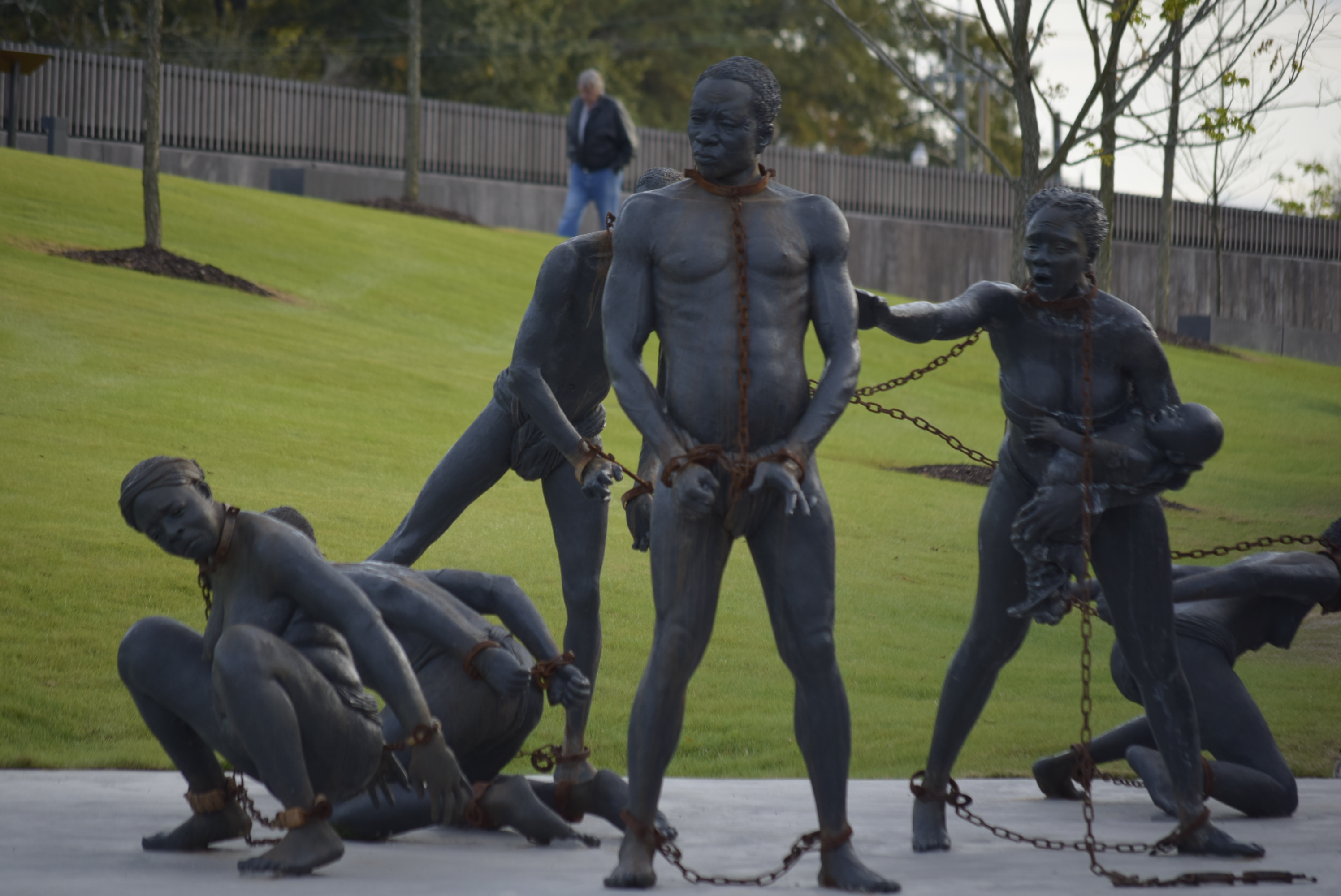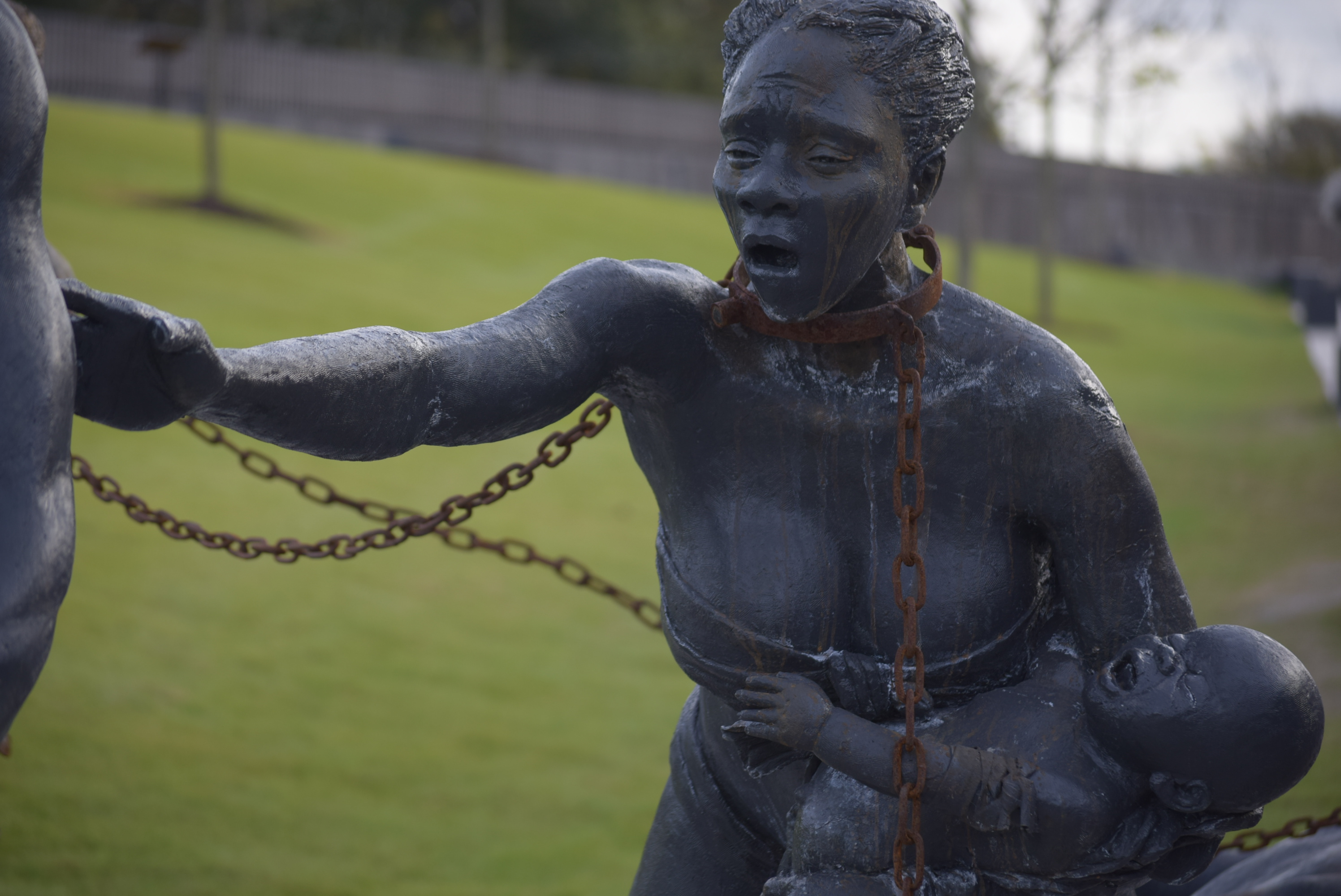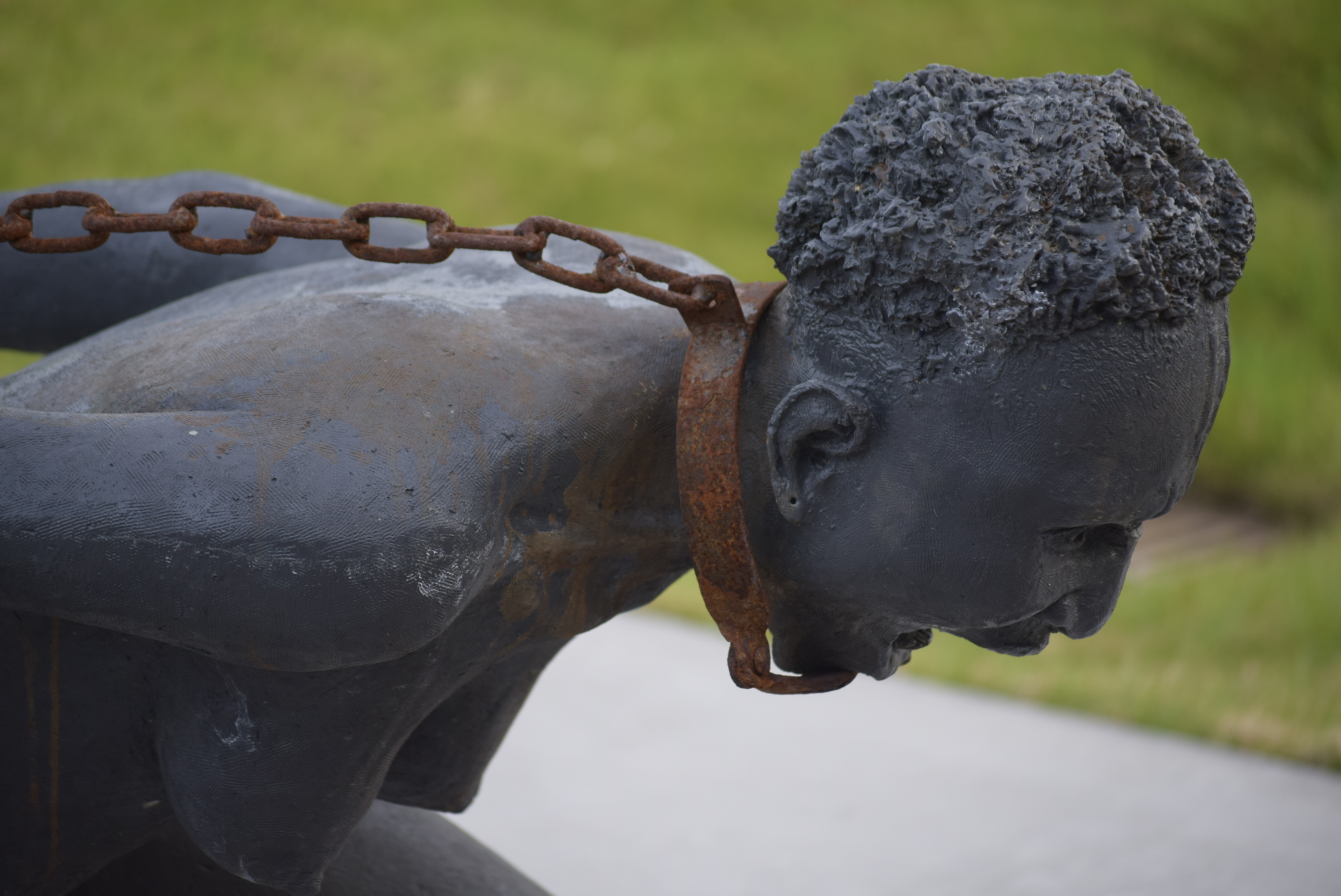
” And O my people, out yonder, hear me, they do not love your neck unnoosed and straight. So love your neck; put a hand on it, grace it, stroke it and hold it up. and all your inside parts that they’d just as soon slop for hogs, you got to love them. “
-Toni Morrison, quote shown here as pictured at the National Memorial for Peace and Justice in Montgomery, Alabama.
Photo credit: JordyProPhoto
In a recent call to anti-racist action noted historian and author Ibram Kendi writes, “The times when all seem lost are the times when we most need to see the people and ideas trailblazing the way out of the muck.”
2018 has been full of muck. I had high hopes that my planned trip to Montgomery, Alabama might offer some clarity to the murkiness of this year. It did not disappoint.
Last week I had the honor of visiting the Equal Justice Initiative National Memorial for Peace and justice, which I had heretofore referred to as the “lynching memorial.” I traveled by car with my twelve-year-old daughter, making an adventure of the more than six hours we would spend driving to Alabama primarily via Highway 85. We planned stops along the way, checking in with my parents and staying overnight with my best friend from high school before hitting the road at around 6:30am to make it to our first meeting in downtown Montgomery at the Civil Rights Memorial Center. The Museum Group (TMG) visited this location and other sites as a part of a longer tour of Montgomery, Alabama’s arts and cultural offerings.
With only a week to process, many of the TMG Members are still reeling from the transformative impact of a memorial experience that calls forth such visceral responses from all who engage.

Although I have traveled to Alabama frequently as an adult I told myself that if I ever had the opportunity to visit with my child, I would take her. I would teach her about this history-drenched state and guide her to a deeper understanding of what role we all play in history. I would, I promised myself, bravely guide her through historic markers, and help her contextualize bombings, and process a landscape still haunted by brutality.
Around 8:30 we arrive at the Civil Rights Memorial Center at the Southern Poverty Law Center, the location of the first meeting. They have a small museum, well-guarded, and small-staffed that opens primarily for student experiences. For years I have utilized their Teaching Tolerance materials and was beyond excited to start with guidance and conversation from their educator, Lecia Brooks, who was helpful, gracious, and especially careful with my baby. Perhaps she knew what was about to happen in these two days.
I was visiting as a member of The Museum Group, TMG, a national collective of museum consultants focused on transforming the field through rigorous dialogue, re-envisioning ethical and sustainable practice. Charmaine Jefferson had taken the lead in organizing what promised to be a whirlwind of sites and learning. I was also visiting as a mother, the constant concern for my child sharpening my awareness of the armed guards, and automatic locks on entrances and exits.
We, the TMG members, mixed the business meeting with breaks to tour the space and watch the opening film- dedicated to the martyrs of the civil rights era. It is during this film that my child, JP looks at me and says, “ I didn’t realize he was so young.” She was referring to Emmitt Till. He was brutally murdered at age 14 by a mob of angry white men. In the short film, they detail exactly how his mother reacts to seeing the tortured body of her child, his face disfigured with one beautiful hazel eyeball touching his chin.
I think that I must have told her this story before. I must have reviewed this history with her even as we prepared for this trip. But then I realize she had no context. It is on this chilled Thursday morning that I understand for her the history was someone else’s until that moment. It belonged to a book, or to a teacher, but it was not her history. It wasn’t her story until she saw the jaunty angle of his hat and a face looking back at us that was about her age.
I write review notes to myself for JP: be sure to review the Children’s March, the Birmingham 4, Ruby Bridges, Claudette Colvin. All Children we have discussed before, but urgently necessary now. These very young and beautiful people were her people now.
I tell her what I can in the hushed crowd of the theater, “Yes, baby, he was very young- and innocent of what he was accused of.”
She says, “And they still killed him?”
She knows the answer to that, too. Young and innocent is not enough if Black is the precursor. She is simply processing her truth yet again. The ridiculous and painful truth is that she could have replaced his name with another teen in Florida, or Ferguson, or Ohio.
She knows this story.

We move through the day, cobbling together a meal for her since I now realize that it is not as easy as I thought to enter and exit the space. She sits quietly observing the rest of the meeting, taking notes and pictures. She is documenting our time in Alabama. For the most part, I let her youth and innocence direct me.
Our understanding of this memory will be different, each of us shaping the experience through the lens of our prior knowledge and emotions. These days in Montgomery seem familiar to her, she knows the threat as real and present, I saw it as historical documentation.
That afternoon we tour both the Memorial for Peace and Justice and the Legacy Museum. First, we were walking, the wrong way apparently, and stopped by a lovely security person who re-directed us. JP asked why she doesn’t simply drive us around the huge city block since she is apparently just sitting there. I told her, “ I think they need security to protect the memorial. There is nothing wrong with our feet and we don’t need protection.” We take pictures along our way, through the barbed wire and junk cars at the edge of the property you can see the memorial on the hill.
A young man sees us as we wind slowly back around and asks, “You all going to that memorial? How much it costs?”
I don’t know, but I guess “ $20?”
“Shooooot! $20! That’s too much, y’all still going to go?”
Yes. We were.
So we walk into a garden of bleeding bodies.
The sheer scale of the memorial, strategically set atop a hill, with hundreds of oxidizing iron columns creates another form of canonization. Thousands of names have been carefully inscribed into the metal faces, boldly proclaiming history that many Americans never directly hear much less encounter.




Sculpture by Ghanaian artist Kwame Akoto Bamfo at the National Memorial for Peace and Justice
The Memorial is a supplement for any mathematics lesson JP is missing from school that day. She peppers me with questions, I point out the answers as quickly as I can. She asks:
How many Africans were brought to the Americas during the Transatlantic Slave Trade?
How many years has it been since it started?
What is the estimated value of domestic slave trade to the United States economy during the 1800s? Now?
How many people had to accuse you before a mob would form to lynch you?
Each of these columns represents a lynching, right? Oh, wrong? So how many lynchings on average happened in each of the over 841 countries represented?
How many people share my family names on these columns/counties in North and South Carolina?
How many people know about this, Mom?
How long has it been since it ended? It ended right?
The Legacy Museum, a short air-conditioned bus ride away, answers that question succinctly: No.
We are right in the middle of a long trajectory of hate, torture, and vile racism.
The Museum portion of the trip situates the experiences of slavery, civil rights abuses, and mass incarceration as central to “American” identity. It takes concerted and sustained effort to resist consciousness of the deep and pervasive racism in our country. It will take a massive effort, constant focus on awareness building, dedication to anti-racist policy, faith that we are the ones to do it, and trust that we will not give up on each other to reverse the course of our history.

Memorialization often takes the form of singular moments frozen in solid form, a static idea of success, valor, and honor. This space unabashedly urges every visitor to action by stepping closer to historically accurate depictions of racialized terror in the American South and beyond. Most visitors follow the tour of the memorial grounds with a visit to a former “slave warehouse” which now functions as the home of The Legacy Museum.
Filled with well-documented and historically accurate first-person narrative, The Legacy Museum makes visible long-ranging terror and firmly situates our country’s complicity in maintaining oppression through mass incarceration.
The Legacy Museum and The National Memorial for Peace and Justice provide a counter-memorialization experience requiring destabilization, movement, and action. On the final day group members were fortunate to speak directly to Bryan Stevenson, founder and one of the most deeply empathetic humans I have ever encountered, about the impact of both the Museum and memorial to the field of museum work. Stevenson started by recognizing that we “have accepted the profound absence of hope.” He offered that in developing the exhibition his team could not engage the typical strategy or the typical museum consultants. Stevenson’s goal was to foster the “consciousness, instinct, and desire in every visitor to say never again” after visiting the sites. Most of our historians and museums in the United States have failed us, he noted, by not guiding us through the terror of white supremacy and instead focusing solely on the celebrations of the civil rights era.
I noted three clear insights from our time together:
- Truth first, then reconciliation. Without this practice, we reconcile to lies and that is no way to heal.
- Make visible the reality. True memorialization makes indisputably visible a system of American racialized terror that has taken a new form, not disappeared.
- Fill your jar. The legacy museum literally asks community members to fill a jar with soil from lynching sites where lives were lost and blood was spilled. It is a practice of honoring loss and active hope.
We all must take our turns filling the jar with stories from our own communities; deliberately getting our hands dirty with the mess of our collective history, and uplifting hope by pursuing justice. These deeply empathetic spaces are designed for action. In Montgomery, I was inspired anew to fearlessly raise my head, even when I felt tears rushing or anger was rising. Raising our collective heads, baring our neck, upward towards the names and history we honor was the only way forward in that space. I am going back. I am raising my daughter to raise her lovely neck, unnoosed and free.

“Darkness cannot drive out darkness; only light can do that. Hate cannot drive out hate; only love can do that.” – Martin Luther King, Jr.

“Truth first, then reconciliation.” Yes. Thanks for your reflections. I hope to meet JP sometime soon.
LikeLiked by 1 person
I struggle for words to express how meaningful your post is. I was not able to join TMG on this visit and know I missed a powerful experience.
Thank you for sharing your heart with me.
LikeLike
Thank you. You see, I don’t know if I ever will have the strength and courage to visit the museum. My dad was from Alabama. Being born in the early part of the 20th century, he was fully aware and probably experienced first hand knowledge of a lynching . When I visited Alabama as I child, the oppression was overwhelming. My spirit can’t handle feeling like that again.
LikeLike